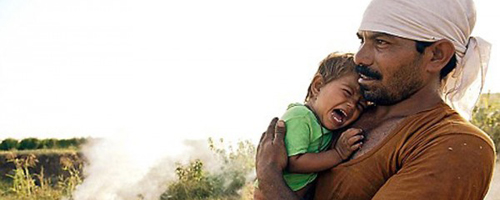Marginalized communities are often situated in slum areas that lack access to proper transportation, Internet coverage and other necessary services that would allow them to become included citizens. Often, their occupation isn't even legally recognized by local authorities. To help the urban poor deal with the great disadvantages and disparities that they face, a number of initiatives have been put in place, including a formalization initiative for Rio de Janeiro's beach vendors, a five-year community-led development plan in Mumbai's most vulnerable slum, a toolkit for spatial planning in Jakarta and a digital literacy campaign in Mexico City. Then, read about the superhighway project in Nairobi that missed an opportunity to include the poor.
Rio de Janeiro's local government is promoting the organization and formalization of the hundreds of beach vendors that sell drinks, snacks and souvenirs on Rio's beaches. The city put in place a series of sanitary and standardization guidelines for vendors to follow, issued permits and started monitoring compliance with safety and sanitary regulations. By formalizing the vendors' status, the local government is indirectly ensuring more secure and stable incomes. The local government even declared certain vendors as part of the city's, "intangible cultural heritage," thus making them an important part in the preservation of local traditions.
 Mumbai's M-Ward is home to the city's dump yard, slaughterhouse and some of the worst squalor in a city of dire extremes. The city found M-Ward to be the perfect place to send its unwanted citizens: The poverty-stricken area has been created by a city pushing the marginalized even further to the margins. In an effort to improve living conditions, the Tata Institute of Social Science has undertaken a massive five-year community-led development initiative. Its ambitious goals include immunizing 100 percent of newborns -- raising school enrollment to 100 percent, and setting up skills training for 1,000 residents annually. The plan is to target critical indicators such as the child mortality rate, infrastructural deficits and access to elementary education as first steps in a large-scale strategic intervention. Last year, students headed out into the slum to begin the first step in the five-year effort: establishing neighborhood-level knowledge centers to perform socioeconomic, demographic and environmental assessments of the people living in M-Ward.
Mumbai's M-Ward is home to the city's dump yard, slaughterhouse and some of the worst squalor in a city of dire extremes. The city found M-Ward to be the perfect place to send its unwanted citizens: The poverty-stricken area has been created by a city pushing the marginalized even further to the margins. In an effort to improve living conditions, the Tata Institute of Social Science has undertaken a massive five-year community-led development initiative. Its ambitious goals include immunizing 100 percent of newborns -- raising school enrollment to 100 percent, and setting up skills training for 1,000 residents annually. The plan is to target critical indicators such as the child mortality rate, infrastructural deficits and access to elementary education as first steps in a large-scale strategic intervention. Last year, students headed out into the slum to begin the first step in the five-year effort: establishing neighborhood-level knowledge centers to perform socioeconomic, demographic and environmental assessments of the people living in M-Ward.
As a response to unequal space utilization in Jakarta, the Rujak Center for Urban Studies (RCUS) recently published an online beginner's guidebook, "Spatial Planning for Us," to provide citizens of informal communities with the basic knowledge they need to become actively engaged in the city's planning process. The toolkit is compiled in easy-to-understand language and its layout -- diagrams, and infographics -- are designed to be simple and attractive to readers. RCUS believes that with access to such information, residents will be able to make decisions regarding their environment and will advocate for equal space utilization in Jakarta.
The Committee for Democracy in Information Technology (CDI) works to reduce the digital literacy gap in Mexico City. The process involves three main steps: training citizens on how to access information technology, developing centers that provide equal opportunity access to all residents and promoting citizen engagement and collaboration to create an open-exchange community where knowledge can be shared. CDI's work has been successful not only in fighting the digital divide, but also in using technology to break the cycle of poverty.
 Kenya missed an opportunity when it launched the Thika superhighway development initiative. A first-of-a-kind flagship "mega project," it marks the initial phase of an urban planning strategy aiming to make Nairobi a world-class city by 2030. The 10-lane road covers the 42 kilometers between Nairobi and Thika, northeast of the capital, and significantly improved the quality of life for many residents in bordering towns, and made the commute into central Nairobi a relatively painless affair. However, it has not been accompanied by any concrete pro-poor interventions, and it risks excluding many of the urban poor who otherwise would have benefited from the upgrade.
Kenya missed an opportunity when it launched the Thika superhighway development initiative. A first-of-a-kind flagship "mega project," it marks the initial phase of an urban planning strategy aiming to make Nairobi a world-class city by 2030. The 10-lane road covers the 42 kilometers between Nairobi and Thika, northeast of the capital, and significantly improved the quality of life for many residents in bordering towns, and made the commute into central Nairobi a relatively painless affair. However, it has not been accompanied by any concrete pro-poor interventions, and it risks excluding many of the urban poor who otherwise would have benefited from the upgrade.
Thanks to the first four initiatives, marginalized communities have an opportunity to be more integrated and included into the rest of the city. The Thika superhighway is useful in providing an example to avoid. Join us on URB.im to share your thoughts about how to improve social inclusion for slum residents in the Global South.